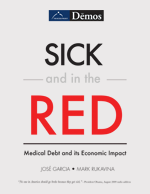For many years, health care costs have been steadily rising. As employers have moved into insurance coverage options with greater out-of-pocket expenses or have stopped providing health care coverage altogether, American families have struggled with the burden of health care costs.
To gain a better understanding of how medical debt impacts families' debt and assets, Demos collaborated with The Access Project to analyze data from its 2008 national household survey of low- and middle-income households with credit card debt. This survey, which consisted of 2,248 phone interviews with low- and middle-income households, collected information about the scope and nature of credit card debt--from the amount and duration of debt to the types of expenses that contribute to household indebtedness.
This report explores the extent to which medical expenses adds to the general credit card debt of households and will examine the impact of such debt on families' economic security. We hope that it helps to inform the public policy discussion on health care affordability and insurance product design.
TOP FACTS:
- In 2008, more than one-half- 52% -of indebted low- and middle-income households cited medical expenses as contributing to their credit card debt.
- When compared to all other expenses inquired about in the survey, out-of-pocket medical expenses were the most frequently reported expense contributing to credit card debt.
- Medically indebted households averaged $11,612 in credit card debt compared with $8,110 for other respondents.
- Medically indebted households carried an average of $2,194 in credit card debt that they attributed directly to medical expenses. Nearly one-third (30 percent) of medically indebted households carry additional medical debt averaging $3,174, owed to other creditors and not reflected on their credit cards.
- Households with medical debt were further burdened by the rate of interest paid on their credit cards; those without medical expenses on their credit cards had an average annual percentage rate (APR) of 14% while the medically indebted had an APR of 16%.
